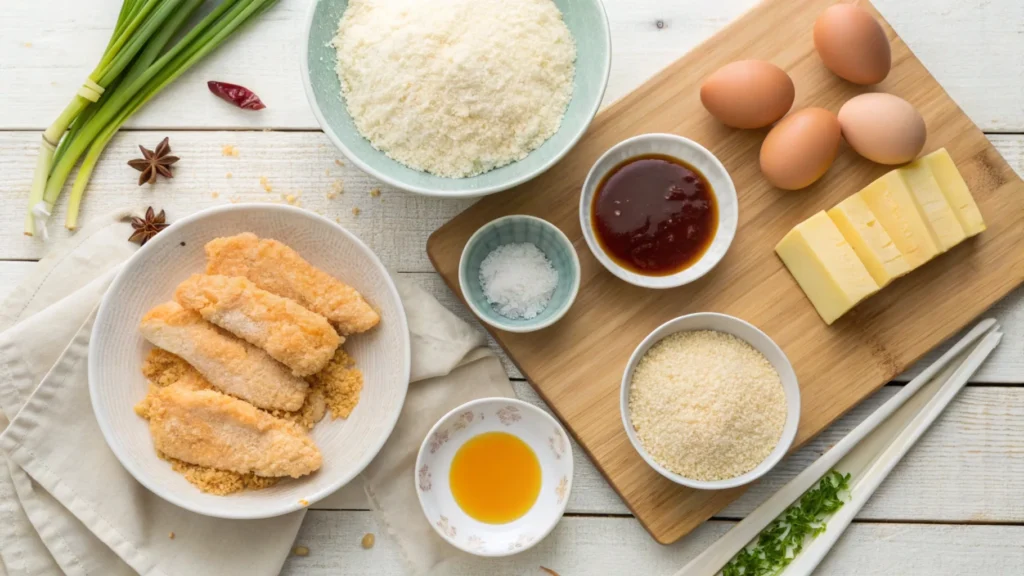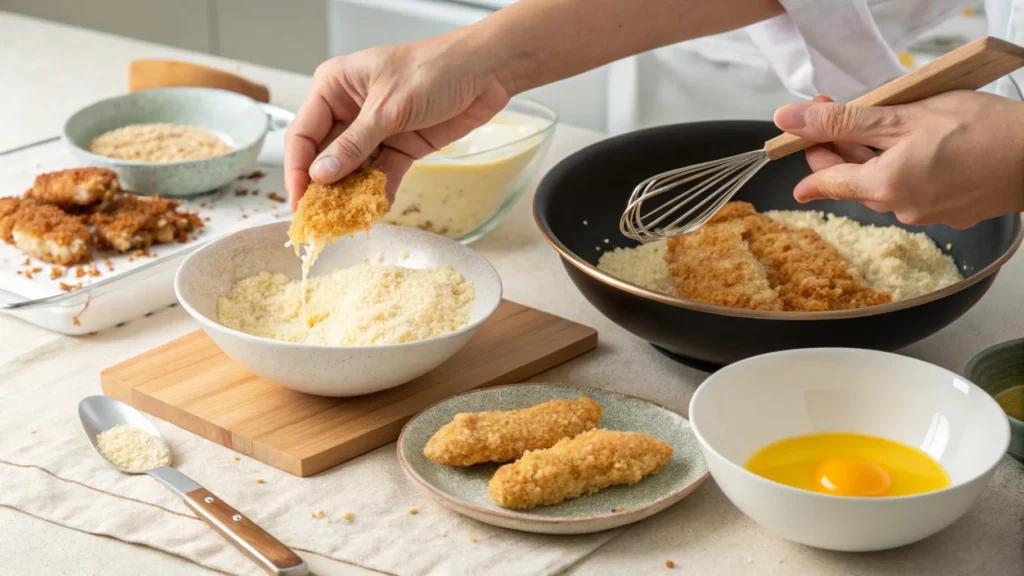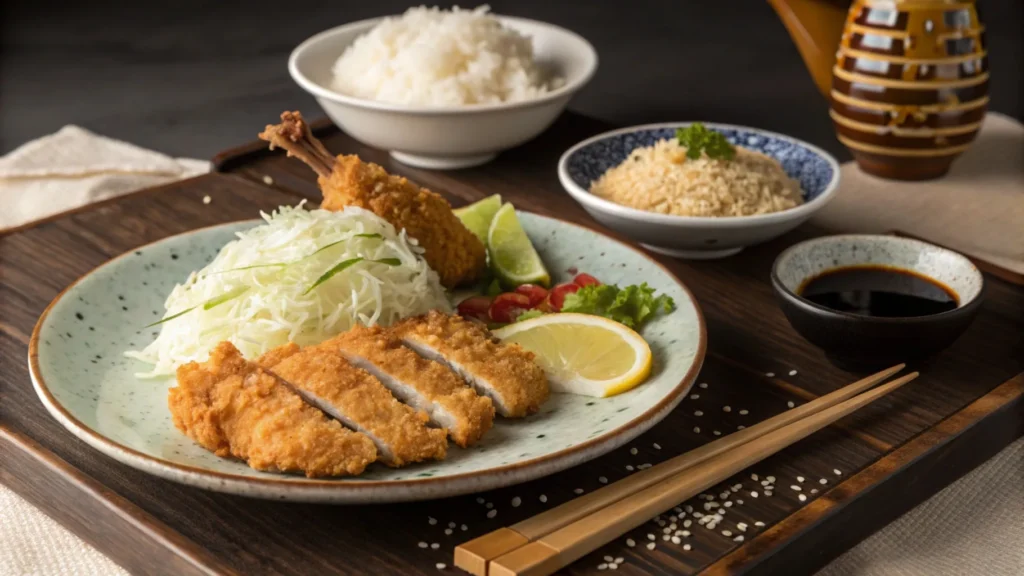Japanese cuisine is full of delicious surprises, and two popular dishes, chicken katsu and chicken tempura, often spark curiosity among food lovers. Both are deep-fried delights, yet they differ in texture, preparation, and taste. In this article, we’ll dive into their origins, compare their unique characteristics, and help you understand what makes each dish special. Whether you’re a fan of crispy chicken or light and airy batter, this guide will give you a clear picture of what separates these iconic Japanese dishes.
Table of contents
Introduction to Chicken Katsu and Chicken Tempura
What Are Chicken Katsu and Chicken Tempura?
To start, chicken katsu is a Japanese fried chicken cutlet coated in crispy panko breadcrumbs. It’s known for its golden-brown crust and hearty bite. On the other hand, chicken tempura features chicken pieces coated in a light, airy batter made with flour and cold water. Instead of being breaded, tempura’s batter creates a delicate, crispy shell that’s distinct from katsu.
Both dishes involve frying, but their textures and techniques couldn’t be more different. While katsu is dense and crunchy, tempura is all about that melt-in-your-mouth crispiness.
Origins and Cultural Significance in Japanese Cuisine
Chicken katsu and chicken tempura both have roots in Japanese culinary traditions, though their stories are quite different. Katsu, inspired by Western-style cutlets, emerged in the late 19th century as a way to adapt European dishes for Japanese tastes. Meanwhile, tempura’s origins trace back to the 16th century, brought to Japan by Portuguese missionaries. Over time, it became a hallmark of Japanese cooking.
Why Compare These Two Popular Dishes?
Many food enthusiasts wonder, what’s the difference between chicken katsu and chicken tempura? While they may seem similar, these dishes cater to different palates and pairings. Understanding their differences can help you decide which to order at a Japanese restaurant—or try making at home!
Preparation Methods and Ingredients

How Chicken Katsu Is Made
Chicken katsu starts with boneless chicken, often a breast or thigh, pounded to an even thickness. This step ensures it cooks evenly. The chicken is then coated in flour, dipped in beaten egg, and finally dredged in panko breadcrumbs, which give it a signature crunch. After breading, the chicken is deep-fried until golden and crispy. The result is a juicy, hearty cutlet with a crisp outer layer.
What makes katsu unique is its robust texture, thanks to the coarse breadcrumbs. The use of oil at a precise temperature ensures the crust is crispy without being greasy. Katsu is usually served with a tangy tonkatsu sauce, which complements the richness of the fried chicken.

The Art of Making Chicken Tempura
In contrast, chicken tempura focuses on lightness. The chicken, typically cut into bite-sized pieces, is coated in a simple batter made of flour, egg, and cold water. The key here is to keep the batter cold, which helps create that airy, crispy texture. Unlike katsu, tempura doesn’t involve breadcrumbs; instead, the batter forms a delicate shell around the chicken.
The pieces are fried quickly in hot oil, giving them a golden, non-greasy finish. Chicken tempura pairs well with a mild dipping sauce, such as tentsuyu, which adds a subtle umami flavor.
Key Ingredient Differences
So, what’s the difference between chicken katsu and chicken tempura when it comes to ingredients? Katsu relies on breadcrumbs for its crunch, while tempura uses a batter for its light, crispy texture. Moreover, katsu is often a whole cutlet, while tempura is typically smaller, bite-sized pieces. These differences not only affect the texture but also influence the overall taste and presentation.
Texture, Flavor, and Appearance
What Makes Chicken Katsu Crispy?
Chicken katsu owes its crunchiness to the panko breadcrumbs, which are larger and coarser than regular breadcrumbs. When fried, they create a thick, golden crust that remains crunchy even after cooling. The texture is sturdy and satisfying, making it ideal for pairing with rich sauces like tonkatsu sauce or serving over a bed of rice in katsudon.
The frying method also contributes to katsu’s crispy finish. Maintaining a consistent oil temperature prevents the breadcrumbs from absorbing excess oil, resulting in a crisp yet non-greasy exterior.
The Light and Airy Texture of Chicken Tempura
On the other hand, chicken tempura has a delicate, almost feathery crispness. This texture comes from the batter, which creates small air pockets as it fries. The cold batter, combined with hot oil, results in a shell that is light yet sturdy enough to encase the chicken. Tempura’s flavor is more subtle, allowing the taste of the chicken to shine through.
Visual and Flavor Differences
Visually, the two dishes are distinct. Katsu’s golden-brown crust looks hearty and uniform, while tempura has a lighter, irregular appearance with crispy edges. Flavor-wise, what’s the difference between chicken katsu and chicken tempura? Katsu offers a rich, savory taste, while tempura has a mild, slightly sweet flavor from the batter. These differences make each dish stand out in its own way.
Nutritional Profile and Dietary Considerations
Calorie Content and Macronutrients
When comparing what’s the difference between chicken katsu and chicken tempura in terms of nutrition, their preparation methods play a key role. Chicken katsu, with its thick panko crust, is calorie-dense due to the breadcrumbs and the deep-frying process. A typical serving of chicken katsu can range from 400 to 600 calories, depending on portion size and the use of oil.
Chicken tempura, on the other hand, uses a lighter batter. While still deep-fried, its calorie count is generally lower, averaging 250 to 400 calories per serving. However, because tempura batter absorbs less oil, it’s slightly less greasy, making it a lighter option overall.
Healthier Options for Both Dishes
For those looking for healthier alternatives, air-frying chicken katsu can significantly reduce calorie content. Additionally, swapping out white flour for whole grain flour in the tempura batter or using lean chicken cuts can further enhance the nutritional profile. Adding fresh vegetables as side dishes, like a salad or steamed edamame, balances the meal nicely. If you’re interested in lighter recipes, check out Air Fryer Chicken Bites for inspiration.
Serving Styles and Accompaniments
Traditional Ways to Serve Chicken Katsu
People commonly pair chicken katsu with tonkatsu sauce, a tangy and slightly sweet condiment that complements its crispy coating. Many serve it alongside shredded cabbage, steamed rice, or even atop a bowl of curry. In Japan, chefs create katsudon by combining chicken katsu with egg and dashi broth over rice, resulting in a hearty meal.
Popular Side Dishes for Chicken Tempura
Chicken tempura is frequently accompanied by tentsuyu sauce, made from dashi, soy sauce, and mirin. It’s also served with grated daikon radish and a side of tempura-fried vegetables like sweet potato, eggplant, or mushrooms. To elevate the dining experience, consider adding Green Spaghetti: Creamy Tex-Mex Pasta as a modern twist.
Fusion and Modern Takes
Cooks often interpret both dishes creatively. They transform chicken katsu into sandwiches or wraps, while they incorporate chicken tempura into sushi rolls or pair it with dipping sauces like spicy mayo. These adaptations showcase their versatility, securing their place as favorites in both traditional and modern cuisines.

FAQs
What Is the Difference Between Katsu and Tempura?
Katsu involves breading chicken with panko crumbs, giving it a thick, crunchy crust. Tempura, however, uses a light batter for a thinner, airy coating, making it less dense.
What Is the Meaning of Chicken Tempura?
Chicken tempura is a fried dish where chicken pieces are coated in a light batter and deep-fried. Its hallmark is the crispy, non-greasy texture that tempura batter provides.
What Does Chicken Katsu Mean?
Chicken katsu means “fried cutlet” and is a Japanese adaptation of Western-style breaded cutlets. It’s often paired with rich, tangy tonkatsu sauce.
What’s the Difference Between Chicken Katsu and Fried Chicken?
Chicken katsu features panko breadcrumbs for an extra crispy finish, while fried chicken usually uses seasoned flour or a wet batter, resulting in a different texture and flavor profile.
Cultural Significance and Global Popularity
How Chicken Katsu Became a Global Favorite
Chicken katsu originated in Japan as a comfort food, often served in casual eateries. Over time, it gained popularity worldwide, thanks to its satisfying texture and adaptable flavors. Its introduction to Western countries, particularly through Japanese restaurants, helped solidify its reputation as a crowd-pleaser. Today, chicken katsu is not only a staple in Japanese menus but also a star ingredient in fusion dishes like katsu sandwiches and tacos.
Why Chicken Tempura Appeals to Diverse Palates
Similarly, chicken tempura has won fans globally due to its light, crispy texture and versatility. Its origins date back to Japan’s Edo period, influenced by Portuguese cuisine. As tempura spread across the globe, it became a favorite in sushi rolls and bento boxes. Unlike katsu, tempura’s mild flavor and delicate coating make it an excellent choice for those who prefer lighter fried dishes. If you’ve ever wondered, what’s the difference between chicken katsu and chicken tempura, the cultural roles of each dish provide another fascinating distinction.
Recipes and Tips for Home Chefs
How to Perfect Your Chicken Katsu
For home chefs, chicken katsu is a rewarding dish to prepare. Start with boneless chicken breasts or thighs, pounding them evenly for uniform cooking. Coat the chicken in flour, beaten egg, and panko breadcrumbs. Fry until golden brown and serve with shredded cabbage and tonkatsu sauce. Pro tip: Use a thermometer to maintain oil at 350°F for consistent results.
Tips for Making Crispy Chicken Tempura
When preparing chicken tempura, keep the batter simple—flour, egg, and cold water are all you need. Cutting the chicken into bite-sized pieces ensures even frying. For extra crispiness, use ice-cold water in the batter and fry in small batches. Serve with tentsuyu sauce or a soy-based dip for authentic flavor. These recipes offer hands-on insights into what’s the difference between chicken katsu and chicken tempura, showcasing their distinct preparation styles.

